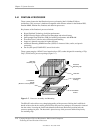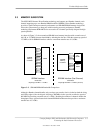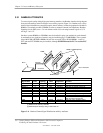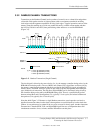
Chapter 3 Processor/Memory Subsystem
Compaq Deskpro EXS and Workstation 300 Personal Computers
Featuring the Intel Pentium 4 Processor
First Edition - December 2000
3-2
3.2 PENTIUM 4 PROCESSOR
These systems each feature an Intel Pentium 4 processor in a FC-PGA423 package mounted with a
passive heat sink in a PGA423 (W-type) zero-insertion force socket. The mounting socket allows
the processor to be easily changed for servicing and/or upgrading.
3.2.1 PROCESSOR OVERVIEW
The 1.4-/1.5-GHz Intel Pentium 4 processor represents the latest generation of Intel’s IA32-class
of processors. Featuring Intel’s NetBurst architecture, the Pentium 4 processor is designed for
intensive multimedia and internet applications of today and the future while maintaining
compatibility with software written for earlier (Pentium III, Pentium II, Pentium, Celeron, and x86)
microprocessors. Key features of the Pentium 4 processor include:
♦ Hyper-Pipelined Technology – The main processing loop has twice the depth (20 stages) of
the Pentium III allowing for increased processing frequencies.
♦ Execution Trace Cache – A new feature supporting the branch prediction mechanism, the
trace cache stores translated sequences of branching micro-operations (µops) and is checked
when suspected re-occurring branches are detected in the main processing loop. This feature
allows instruction decoding to be removed from the main processing loop.
♦ Rapid Execution Engine – Arithmetic Logic Units (ALUs) run at twice (2x) processing
frequency for higher throughput and reduced latency.
♦ 256-KB Advanced transfer L2 cache – Using 32-byte-wide interface at processing speed, the
L2 cache can provide 48 GB/s perrformance (3x over the Pentium III)
♦ Advanced dynamic execution – Using a larger (4K) branch target buffer and improved
prediction algorithm, branch mis-predictions are reduced by an average of 33 % over the
Pentium III.
♦ Enhanced Floating Point Processor - With 128-bit integer processing and deeper pipelining
the Pentium 4’s FPU provides a 2x performance boost over the Pentium III.
♦ Additional Streaming SIMD extensions (SSE2) – In addition to the SSE support provided by
previous Pentium processors, the Pentium 4 processor includes an additional 144 MMX
instructions, further enhancing:
• Streaming video/audio processing
• Photo/video editing
• Speech recognition
• 3D processing
• Encryption processing
♦ Quad-pumped Front Side Bus (FSB) – The FSB uses a 100-MHz clock for qualifying the
buses’ control signals. However, address information is transferred using a 200-MHz strobe
while data is transferred with a 400-MHz strobe, providing a maximum data transfer rate of
3.2 GB/s. This is a 3x boost over a Pentium III with a 133-MHz FSB. The 3.2 GB/s peak
transfer rate of the FSB balances the 3.2 GB/s maximum transfer capability of the dual-
channel Direct Rambus system memory.


















